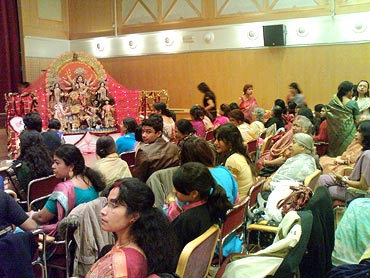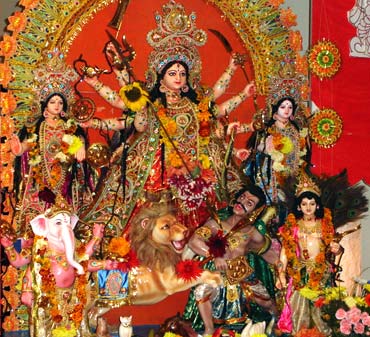Photographs: Courtesy Manjoori Ganguly
Manjoori Ganguly recalls her first Durga Puja celebration in Sweden.
One can take a Bengali out of Bengal, but never Bengal out of a Bengali, and everywhere a Bengali goes, Bhaanpa Ileesh (Steam-cooked Hilsa fish), Robindro shongeet (the music of Rabindranath Tagore) and Durga 'pujo' (as Bengalis say it) follow.
And there is no one more possessive about their culture, especially Durga Pujo, as a Bengali in a foreign country.
I cannot slot myself as the typical Bengali from West Bengal. I hail from Maharashtra and am considered very non-Bengali because my knowledge of Robindro shongeet is limited, I use both my hands and a fair share of unmentionable expressions when I dig into a piece of Bhaanpa Ileesh and I don't instinctively go 'eeeeeeeeeeesh' like Aishwarya Rai Bachchan did in Devdas.
However, Durga pujo is another story; a story deeply etched in my Bengali DNA.
It is not just the annual homecoming of the Mother, with her four children to their maternal grandfather's abode. For Bengalis, it is a season to be more Bengali than ever. You can sense it in the air, when the sun begins to lose its ferocity and there is a gentleness in the breeze, a fragrance of wet clay being formed into the 10-armed idols of Goddess Durga and big boards screaming 'Sale' all over West Bengal.
My upbringing in Maharashtra did not affect my susceptibility to the pujo fervour and everywhere my husband and I relocated, we always found our way to the closest festivities. It was important that we recast ourselves into the Bengali mould at least once every year, for the four days of the festival, accompanied by the beating of the dhaak (a traditional drum), the fragrance of incense in the dhunuchi dance, the blowing of conch shells, and the crisp and colorful cotton saris of the women drape and the hand-painted designer kurtas of the men.
Relocating to Sweden six years ago, we made a beeline for the Durga pujo venue as soon as we heard that there was an association of ardent, migrant Bengalis who organise the festival every year.
Stockholm has a population of about two million, of which may be 2,000 are Bengalis. A handful out of them continue the legacy of the four migrant families who started the pujo celebration out of the basement of a house sometime in the 1980s; four migrant Bengali families, who were determined to bring the culture of their homeland to the cold, foreign and faraway shores of Sweden.
atics to writing.
'As I looked up to the goddess, a tear trickled down my cheek'
Photographs: Courtesy Manjoori Ganguly
My first introductions to Goddess Durga and her entourage in Stockholm were in a tiny hall over a shopping centre in a southern district on a cold October day in 2005. The goddess had to adjust her visit to fit into a weekend that fell closest to her scheduled visit according to the Hindu calendar, because the organisers and visitors could only be free on weekends. I had to get over the idea of holidays during the festival. She and her children were bejeweled, but nothing could compare to the glitter borne by the ladies in that little hall. Draped in their finest saris, and sporting large bindis and vermillion, they had seen to it that their children, too, projected a Bengali look. Well, I said to myself, it is the last chance to dress up before we are covered by layers and layers of warm clothing to beat the cruel winter.
From the pushpanjali (floral offerings to the goddess) and bhog (food offered to the goddess) to the Khichdi, Payesh (the Bengali version of Kheer) and the final mouth freshening paan (stuffed betel leaf), it was all there, much like it is back in India.
The organising committee had not missed a thing. The dhaaki (drummer), the reverberating sound of conch-shells, the cacophony, the ambience, the Bengali heartbeats -- I experienced it all in that tiny little hall that was hired for the weekend.
Any Durga pujo is incomplete without cultural performances in the evening, and since no self-respecting Bengali would let go of an opportunity to belt out a few Tagore songs (there is one for every occasion and every emotion), children trained in dance and music put together a cultural show. Proof of the fact that a piece of Bengal resides in every Bengali, no matter where he or she lives.
Although not the same thing as the celebrations in India, my first Durga pujo in Stockholm came pretty close to the real thing, as close as one can get, being thousands of miles away from home.
As I looked up to the Goddess Durga in all her finery, standing tall at a modest seven feet, a tear trickled down my cheek. Not because I missed my country and its festivities, but because I knew that no matter what the size of the idol and the scale of the festivities, the sentiments and the emotions that come with this purely Bengali festival of Durga Puja will always be unadulterated and undiluted.



Comment
article